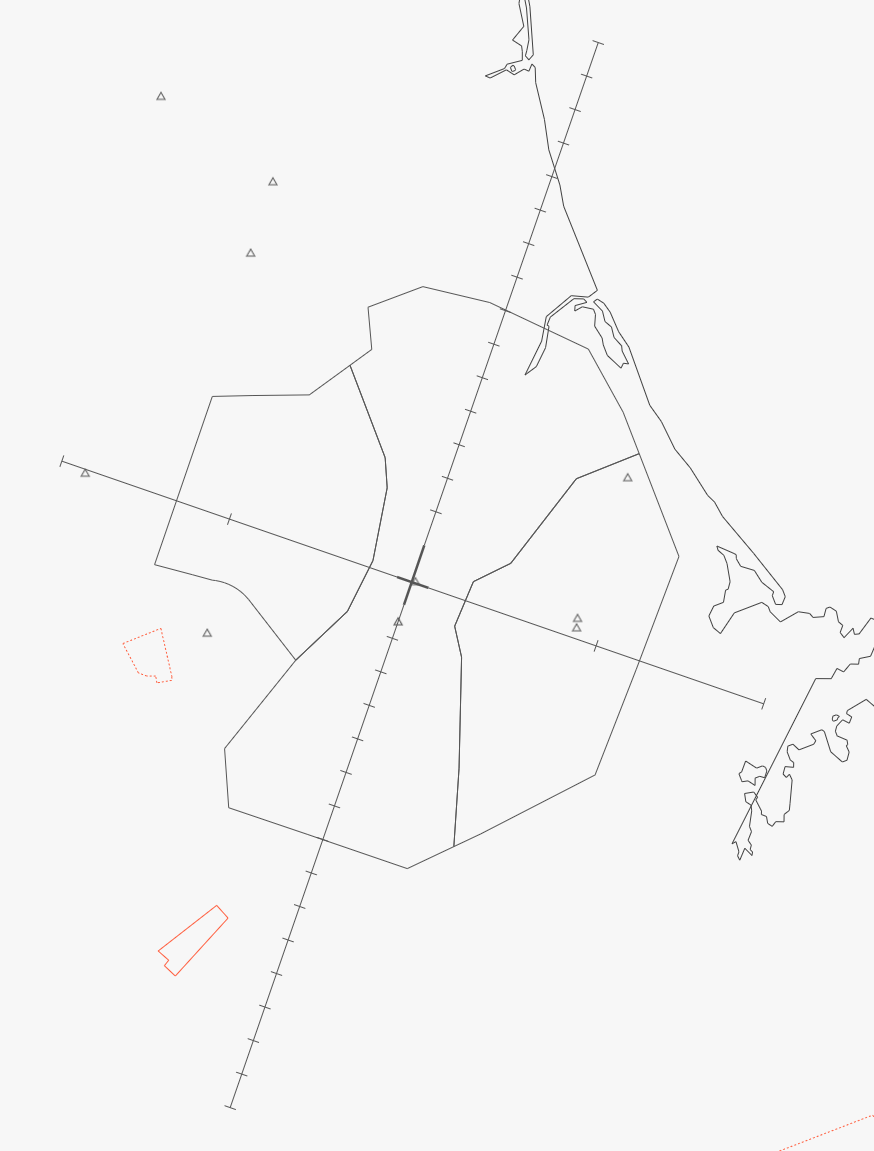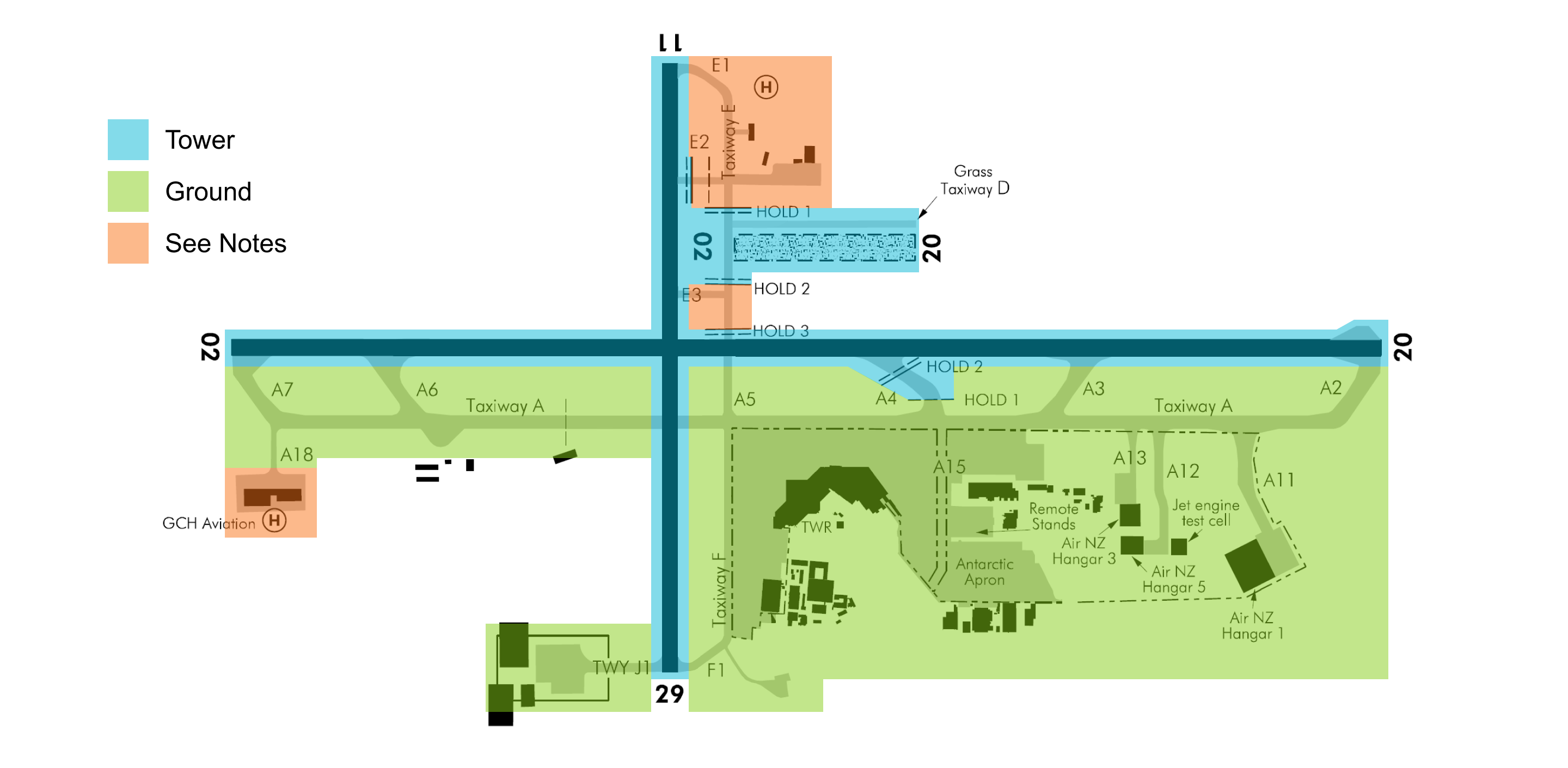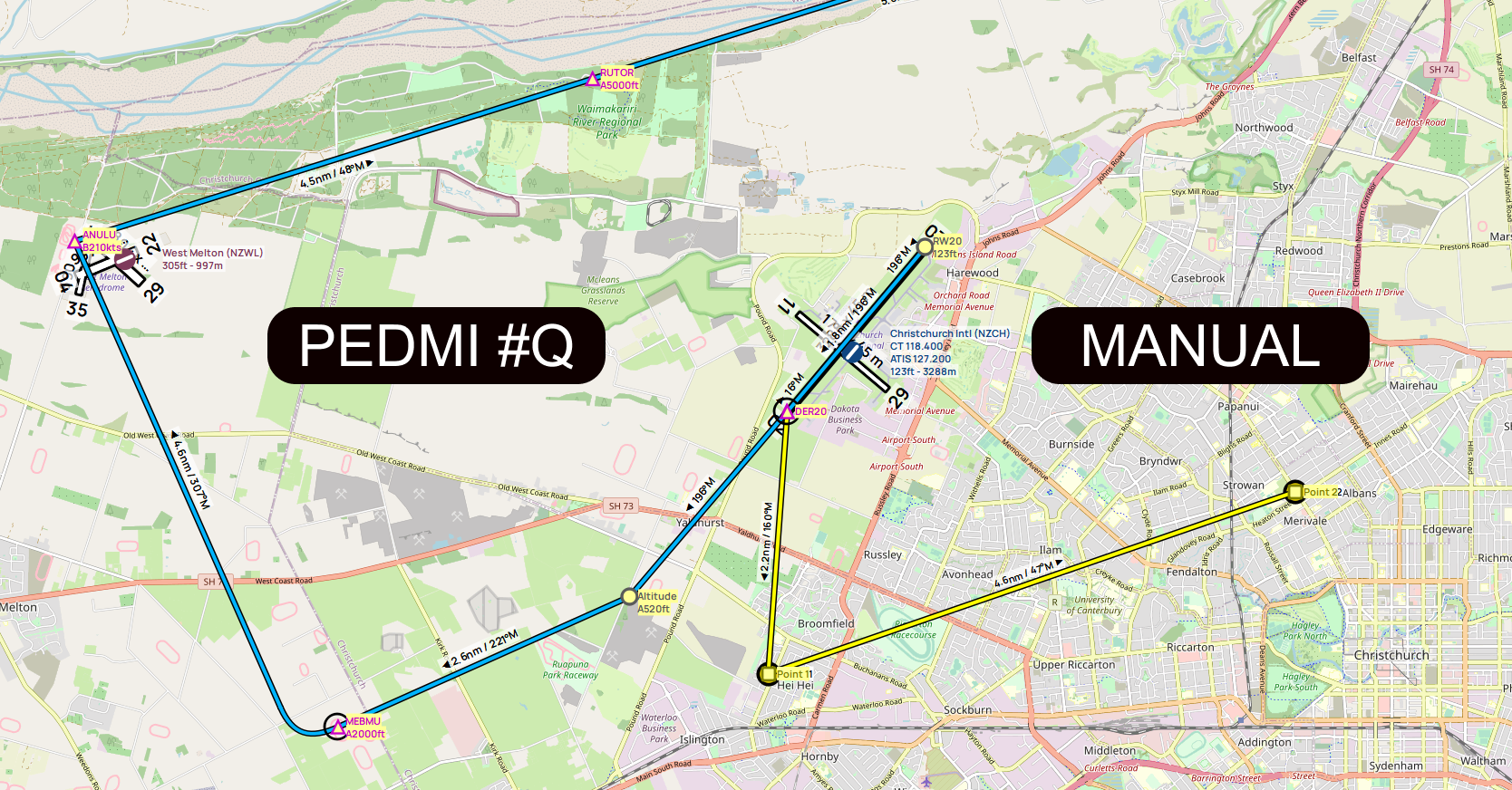NZCH - Christchurch
Positions
| Position Name | Shortcode | Callsign | Frequency | Login ID | Usage |
|---|---|---|---|---|---|
| Christchurch DLV | DCH | Christchurch Delivery | 128.200 | NZCH_DEL | Secondary |
| Christchurch SMC | GCH | Christchurch Ground | 121.900 | NZCH_GND | Secondary |
| Christchurch TWR | TCH | Christchurch Tower | 118.400 | NZCH_TWR | Primary |
| Christchurch TMA | CTMA | Christchurch Approach | 126.100 | NZCH_APP | Primary |
Event Only Positions
Event Only Positions
The following are designated as Event Only positions, and may only be staffed during a VATNZ event where approved, or if explicitly authorised by the Operations Director.
| Position Name | Shortcode | Callsign | Frequency | Login ID | Usage |
|---|---|---|---|---|---|
| Christchurch Terminal Radar | CDEP | Christchurch Departures | 120.900 | NZCH_DEP | Events - Traffic Management |
Airspace
The Christchurch CTR/C follows the lateral boundaries as shown below from SFC to A015. The CTR/C comprises of three sectors - the West, Instrument and East Sectors.
Areas of Responsibility
The areas of responsibility are as depicted below.
Notes
The areas marked in orange have special condition-based rules, and can be read about here - GCH Apron and Western Apron.
Transfer of Control Points
| Transfer Flow | Requirements | Notes |
|---|---|---|
| Delivery -> Ground | Once PDC has been issued either through Voice or DCL | Exceptions for the Western and GCH aprons. |
| Ground -> Tower | Prior to arriving at their assigned hold, once clear of other traffic. | See conditions for traffic crossing a Rwy and traffic backtracking via Rwy 29. |
| Tower -> Ground | Once clear of the active Rwy. | Tower may taxi aircraft vacating via A4 to A4 Hold 1 without coordination. |
| Tower -> Approach | For Airline traffic, once airborne. For GA traffic, prior to leaving the zone, if applicable. | |
| Approach -> Tower | Once established on an instrument final, or overhead the IAF if on an RNP approach. |
Control Positions
Clearance Delivery
Clearances shall be issued by the Delivery position, and may given via DCL or voice.
When applicable, Delivery may issue taxi instructions in line with the GCH Special Conditions or Western Apron Special Conditions.
Ground
Pushback
Pushback and startup clearances are managed by the Ground Controller. Due to the single taxiway at NZCH, the Controller shall ensure that pushbacks are carefully timed to allow for aircraft to taxi to both the runway and stands.
Starting on Stand at the Terminal
Christchurch utilises W/E stands to allow for Props to park into the wind. Aircraft utilising these stands do not require a push-back, and may start on stand.
| Stands / Gates | Usage | Has a W/E stand? | Pushback Location | Notes |
|---|---|---|---|---|
| 3 and 4 | Cat B Props | Yes, only | N/A | Designed for C208 or PC12 type aircraft |
| 5 to 8 | Turboprops | Yes | Twy F |
Both Nose-in, and W/E |
| 9, 11, 12, 13, 15 | Turboprops | Yes | Twy F |
Both Nose-in, and W/E |
| 10, 14 | Turboprops | No | Twy F |
|
| 16 | Turboprops and Jets | No | Twy F |
|
| 17 to 22 | Turboprops and Jets | No | Twy A |
Primarily for Jets, but turboprop capable |
| 26 to 28 | Jets | No | Twy A |
If Rwy 02 is active, Stand 28 shall be pushed clear of A4, or may be pushed on A15 |
| 29 to 35 | Jets | No | Twy A15 |
International Stands |
Use of Holding Points
Departures may occur from any intersection, providing that it does not interfere with the use of normal exits.
RWY 02
When Runway 02 is in use, domestic jet traffic shall be issued A6, and international traffic issued A7. Domestic jet traffic may be re-issued A7 if requested from the Pilot.
Departing prop traffic is usually able to take a mid-field departure via A5 or RWY 29. Arriving prop traffic will usually vacate via A5, so traffic may be instructed to hold short of RWY 02/20 on RWY 29, provided that Tower has delegated the use of Runway 29 to Ground.
RWY 20
When Runway 20 is in use, domestic jet traffic shall be issued A3, and international traffic issued A2. Domestic jet traffic may be re-issued A2 if requested by the Pilot.
Departing prop traffic shall be issued A4, but may be re-issued A3 if required for performance.
High Performance Aircraft
High performance aircraft, such as private jets or King Airs, may be issued any holding point, provided that it does not interfere with landing traffic. If a high performance aircraft is using a usual vacate route, any aircraft on approach shall be notified and instructed to roll out to the next runway vacate point.
Dakota Apron
Dakota Apron is used exclusively by Parcel Air (APK), Airwork (AWK) and Texel Air (XLR). Aircraft utilising this apron may be instructed to start at their discretion and report for taxi.
When ready for taxi, aircraft taxiing from the Dakota Apron may be instructed to cross Runway 29 and taxi via F, or may be given a backtrack via Runway 29. A backtrack via Runway 29 is usually preferred, as it allows the Domestic ramp to continue to flow.
Post Apron
The Post Apron is on the northern side of A4, and is used by DHL, Qantas Freight and other freight traffic. Aircraft utilising this apron may be instructed to start at their discretion.
Romeo Apron
The Romeo Apron is a transitional apron, and is commonly used by aircraft arriving at the aerodrome without a contracted parking location, or for overflow or long-term parking.
Aircraft utilising Stands R1A, R1B, and R3A stands may start on stand. Aircraft utilising Stands R1, R2 or R3 must be pushed onto A15.
Antarctic Apron
The Antarctic Apron is used for all military traffic, but may also be used for larger private traffic. Stands are not issued on this apron, and aircraft may start on stand.
West of RWY 02/20
Aircraft operating within the bounds of the Western Apron shall be controlled in line with the Western Apron special conditions.
Use of RWY 29/11 as a Taxiway
When RWY 29/11 is not in use Tower may delegate the use of RWY 29, south of the RWY 02/20 intersection, to Ground as a taxiway.
Traffic crossing intersecting Runway
When delegated RWY 29, the Ground Controller may authorise the aircraft to cross RWY 29 without seeking permission, or transferring that aircraft to Tower.
When Runway 29/11 is in use
The Ground Controller shall not assume crossing authority for the intersecting runway when Runway 29/11 is in use.
RTF for crossing a Runway
Christchurch Ground: "ANZ218, taxi holding point A6, Runway 02, via A. Cross Runway 29"
Backtrack via Rwy 29
When delegated RWY 29, aircraft taxiing to or from the Dakota apron may be instructed to backtrack via RWY 29, avoiding taxiway F. Domestic prop traffic taxiing to or from the Domestic apron may also be instructed to backtrack via RWY 29 in order to avoid congestion on taxiway F.
Tower
In normal operation, RWY 02/20 shall be used. The use of RWY 29/11 is detailed in the special conditions section.
The Tower shall ensure that all VFR traffic within the Christchurch CTR/C does not conflict with any IFR operations. IFR operations shall take precedence over VFR.
Unless established within the aerodrome circuit, Tower must ensure that no VFR aircraft are present within the Instrument Sector when an aircraft is either turning onto, or established on an approach. VFR aircraft are not authorised to operate under any approach path, or within 3nm laterally of the approach path.
When RWY 02/20 is in use, aircraft that have been cleared to operate within the West or East sectors are deemed to be separated from IFR arrivals on the ILS or RNP Z approaches, but not from RNP (AR) approaches. When RWY 29/11 is in use, VFR aircraft shall not be authorised to operate within the West, East or Instrument sectors.
Simultaneous use of Grass and Sealed 02/20
The simultaneous use of Grass and Sealed 02/20 is authorised, except that:
- Aircraft in the grass circuit must be informed of the arriving sealed traffic, and instructed to remain clear of the sealed runway.
- Aircraft on approach for the sealed runway must be informed of the grass traffic.
- When an aircraft using the sealed is under
A010, no grass traffic shall be authorised to turn base leg, and must be instructed to hold in the downwind until the sealed traffic has landed. - There shall be no simultaneous use of the grass and sealed when sealed traffic is departing. In this case, grass traffic shall be instructed to hold in the downwind.
Departures
Aircraft departures shall be managed in-line with the Runway Operations section
For the purposes of arrival and departure management, all Christchurch departures shall be treated as divergent - providing that the aircraft on approach is at the same, or lower approach category.
SID Assignment
There are no discrete prop or jet SIDs at Christchurch, and the Controller shall issue the departure suggested by the Controller Client.
Assigned Headings for PEDMI departures
Where multiple departures have been assigned the PEDMI #Q SID, the Tower Controller may, with coordination with CH TMA, instruct the aircraft to fly a heading of 160°M and climb to A050.
Where a prop and jet have both been assigned the PEDMI #Q, the jet shall be issued the assigned heading due to its capacily to climb faster above the city.
RTF and coordination for Assigned Heading departure
CH TWR -> CH TMA: "Successive PEDMI departures. Request ANZ631 assigned heading 160°M climbing five thousand then yours for vectors. Second in queue."
CH TMR -> CH TWR: "ANZ631 approved heading 160 climbing five thousand then my vectors. Copy second in line."
Christchurch Tower: "ANZ631, additional departure instructions, report ready to copy"
ANZ631: "ANZ631, ready to copy"
Christchurch Tower: "ANZ631, on departure turn left heading 160, climb five thousand."
ANZ631: "On departure turn left heading 160, climbing five thousand. ANZ631."
A050. Visualization in LittleNavMap and accurate as of AIRAC 2304.Special Conditions
Section still under development
This section is still under development.
Please note that these are special conditions that deviate away from norms. In this case, where a section links here, use your best judgement in the interim.
=======
This is a work in progress!
This page is currently being worked on by the team. It'll be here soon! If you want to help out, have a look how you can help!


